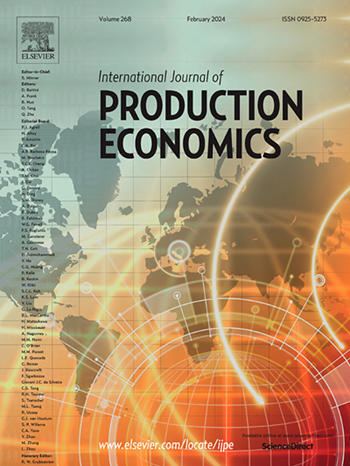多级库存系统的节能优化
IF 9.8
1区 工程技术
Q1 ENGINEERING, INDUSTRIAL
引用次数: 0
摘要
在冷供应链中有效的能源管理对于降低成本和环境影响至关重要。本研究提出了一个集成的分销库存系统,重点关注整个供应链的能源考虑。该模型将生产、仓储和运输过程中的能源使用纳入系统的平均总成本,提供了对能源成本组成部分的全面分析。通过考虑生产率、订购政策、仓库填充水平和卡车类型等各种因素,该模型可以深入了解系统的能源效率。该模型是一个混合整数非线性规划(MINLP)问题。为了解决这一问题,提出了一种启发式算法,旨在优化包括能源成本在内的总成本,同时提供接近最优的决策变量。一项基于现实世界公司的研究可以作为该模型有效性的实际例证。综合库存系统与非库存系统的对比显示,仓储能耗(23.85%)和整体系统成本(2.74%)显著降低。在对四组数据集进行测试后,提出的启发式算法在成本最小化(前两组)和计算时间方面优于LINGO求解器,验证了其效率。进行敏感性分析以评估关键参数的影响,如能源单位成本、距离、运输速度和对能源成本和系统性能的需求。这些分析为决策者提供了有价值的见解,支持明智的决策和确定优化能源使用的实用策略。本文章由计算机程序翻译,如有差异,请以英文原文为准。
Energy-efficient optimization of multi-echelon inventory systems
Efficient energy management in the cold supply chain is crucial for reducing costs and environmental impact. This study presents an integrated distribution inventory system that focuses on energy considerations throughout the supply chain. The model incorporates energy usage from production, warehousing, and transportation processes into the average total cost of the system, providing a comprehensive analysis of energy cost components. By considering various factors such as production rate, ordering policy, warehouse filling level, and truck types, the model offers insights into the energy efficiency of the system. The model is formulated as a mixed-integer nonlinear programming (MINLP) problem. To solve this problem, a heuristic algorithm is proposed, aiming to optimize the total cost, including energy costs, while providing near-optimal decision variables. A study based on a real-world company serves as a practical illustration of the model’s effectiveness. A comparison between the integrated inventory system and a non-inventory system reveals significant reductions in energy consumption for warehousing (23.85%) and the overall system costs (2.74%). After testing four groups of datasets, the proposed heuristic algorithm outperforms the LINGO solver in terms of cost minimization (for the first two groups) and computational time, validating its efficiency. Sensitivity analyses are performed to assess the impact of key parameters such as energy unit costs, distance, transportation speed, and demand on energy costs and system performance. These analyses provide valuable insights for decision-makers, supporting informed decision-making and the identification of practical strategies for optimizing energy usage.
求助全文
通过发布文献求助,成功后即可免费获取论文全文。
去求助
来源期刊
CiteScore
21.40
自引率
7.50%
发文量
266
审稿时长
52 days
期刊介绍:
The International Journal of Production Economics focuses on the interface between engineering and management. It covers all aspects of manufacturing and process industries, as well as production in general. The journal is interdisciplinary, considering activities throughout the product life cycle and material flow cycle. It aims to disseminate knowledge for improving industrial practice and strengthening the theoretical base for decision making. The journal serves as a forum for exchanging ideas and presenting new developments in theory and application, combining academic standards with practical value for industrial applications.

 求助内容:
求助内容: 应助结果提醒方式:
应助结果提醒方式:


